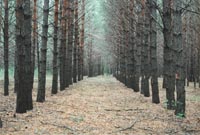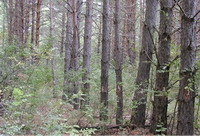|
Полный текст html
Полный текст pdf
"Хвойные бореальной зоны" 2009г., №1, с.
33-41
Oсновная причина массового усыхания пихтово-кедровых лесов в горах Восточного Саяна – Корневые патогены
И.Н. Павлов, О.А. Барабанова, А.А. Агеев, А.С. Шкуренко, С.С. Кулаков, Д.В. Шпенглер, П.В. Губарев
ГОУ ВПО «Сибирский государственный технологический университет»
660049 Красноярск, пр. Мира, 82; e-mail: forester24@mail.ru
Установлена активизация процессов куртинного усыхания коренных темнохвойных лесов (Abies sibirica, Pinussibirica) в горах Восточного Саяна в последнее десятилетие. Гибель деревьев вызвана комплексом корневых патогенов (Heterobasidion parviporum Niemela & Korhonen, Armillaria mellea s.l., Phellinus sulphurascens Pilat.). Изменение климата, лесозаготовки, техногенное загрязнение – главные причины активизации патогенных свойств возбудителей корневых гнилей. Фактором, способствующим очаговому проявлению заболевания, является снижение биологической устойчивости древесных растений из-за ограничения роста корневых систем пихты и кедра на неглубоких почвах (корнеобитаемый слой 15-25 см), подстилаемых твердыми горными породами.
Ключевые слова: Heterobasidionparviporum Niemela & Korhonen; Armillariamellea s.l.; Phellinussulphurascens Pilat.; Восточный Саян
Drying of trees with increasing frequency has been noted last decade for native dark coniferous forests (Abies sibirica, Pinus sibirica) in the Eastern Sayan Mountains. Suggested that root rot fungal pathogens (Heterobasidion parviporum Niemela & Korhonen, Armillaria mellea s.l., Phellinus sulphurascens Pilat.) were the important cause of tree mortality. Climate change, woodcutting, anthropogenic pollution are the main reasons of the root rot pathogens activation.An additional important factor promoting the appearance of root rot disease is decreasing biological stability of trees because of limited growth of root systems of Siberian fir and Siberian pine in the insignificant root layer (15-25 centimeters) in conditions of spreading hard rocks under.
Key words: Heterobasidion parviporum Niemela & Korhonen; Armillaria mellea s.l.; Phellinus sulphurascens Pilat.; Eastern Sayan Mountains
БИБЛИОГРАФИЧЕСКИЙ СПИСОК
- Алексеев, В.А. Побеговый рак пихты сибирской. Описание болезни и методические рекомендации по его полевой диагностике / В.А. Алексеев, Д.А. Шабунин. - СПб: СПб НИИЛХ, 2000. - 29 с.
- Бондарцева, М.А. Определитель грибов СССР. Афиллофоровые грибы / М.А. Бондарцева, Э.Х. Пармасто. -. – Л: Наука, 1986. - Вып. 1. - 180 с.
- Власенко, В.И. Усыхающие ельники среднего Сихотэ-Алиня / Власенко В.И. // Ритмы и катастрофы в растительном покрове российского Дальнего Востока: Материалы Международной научной конференции, Владивосток, 12-16 окт., 2004. - Владивосток, 2005. - С. 129-135.
- Манько, Ю.И. Мониторинг усыхания пихтово-еловых лесов в центральной Сихоте-Алине / Ю.И. Манько [и др.]. // Лесоведение. – 1998. - №1.– С. 3-15.
- Манько, Ю.И. О факторах усыхания пихтово-еловых лесов на Дальнем Востоке / Ю.И., Манько, Г.А. Гладкова // Лесоведение. – 1995. –№ 2. – С. 3-12.
- Манько, Ю.И. Усыхание ели в свете глобального ухудшения темнохвойных лесов / Ю.И., Манько, Г.А. Гладкова- Владивосток: Дальнаука, 2001. - 231 с.
- Мозолевская, Е.Г. Роль болезней и вредителей в ослаблении и усыхании пихты в Байкальском заповеднике в середине 80-х годов / Е.Г. Мозолевская, Т.В. Галасьева, Э.С. Соколова // Лесной вестник. – 2003. - №2. – С. 136-142.
- Негруцкий, С.Ф. Корневая губка / С.Ф. Негруцкий. — М.: Агропромиздат, 1986, — 196 с.
- Федоров, Н.И. Корневые гнили хвойных пород / Н.И. Федоров. – М.: Лесная промышленность, 1984. – 160 с.
Angwin, P.A. Pairing tests to determine mating compatibility in Phellinus weirii / P.A. Angwin, E.M. Hansen // Mycol Res 97, 1993.- P. 1469–1475.
- Bier, J.E. Relation of research in forest pathology to the management of second growth trees / J.E. Bier, D.C. Buckland / B.C. Lumberman, 1947.-№ 31(1). - Р. 49-51, 64, 66.
- Childs, T.W. Poria weirii root rot / T.W. Childs // Phytopathology, 1963. - №53. – Р. 1124–1127.
- Filip, G.M. Susceptibility of native conifers to laminated root rot east of the Cascade Range in Oregon and Washington / G.M. Filip, C.L. Schmitt // Forest Science. – 1979. - №25. – Р. - 261-265.
- Goheen, D.J. Effects of pathogens and bark beetles on forests / D.J. Goheen, E.M. Hansen // Beetle-pathogen interactions in conifer forests. - London: Academic Press. - 1993. - P. 175-196.
- Hadfield, J.S. Laminated root rot, a guide for reducing and preventing losses in Oregon and Washington forests / J.S. Hadfield.- Portland, OR: U.S. Department of Agriculture, Forest Service, Pacific Northwest Region. - 1985. -13 p.
- Hansen, EM Survival of Phellinus weirii in Douglas-fir stumps after logging / EM Hansen // Can J For Res. – 1979. – №9. – Р. 484–488.
- Kotlaba, F. Revision of the original material of Phellinus sulphurascens Pil., Xanthochrous glomeratus ssp. heinrichii Pil. and Polyporus rheades Pers. (Hymenochaetaceae) / F. Kotlaba, Z. Pouzar // Ceska Mykologie. – 1970. - №24. – P.146-152.
- Larsen, M.J. Phellinus (Hymenochaetaceae) / M.J. Larsen, L.A. Cobb-Poulle // A survey of the world taxa. Synop Fung. – 1990. - №3. – P. 1-206.
- Larsen, M.J. Phellinus sulphurascens and the closely related P. weirii in North America // M.J. Larsen, F.F. Lombard, J.W. Clark // Mycologia. – 1994. - №86. – P. 121-I30.
- Lim Y.W. Differentiating the two closely related species, P. weirii and P. sulphurascens / Y.W. Lim, Y.C.A. Yeung, R.N. Sturrock, I. Leal, C. Breuil // Forest Pathol. – 2005. - №35. – P. 305–314.
- Lim, Y.W. Distinguishing homokaryons and heterokaryons in Phellinus sulphurascens using pairing tests and ITS polymorphisms / Y.W. Lim, et. al. // Antonie Van Leeuwenhoek. – 2008. - №93. – P. 99-110.
- Murrill, W.A. An enemy of the western red cedar / Murrill, W.A. // Mycologia. – 1914. - №6. – P. 93-94.
- Nagel, T.A. Intermediate wind disturbance in an old-growth beech-fir forest in southeastern Slovenia / T.A. Nagel, J. Diaci // Can. J. Forest Res 36. - 2006. - № 3. - С. 629-638.
- Nelson, E.E. Colonization of wood disks initiated by basidiospores of Phellinus weirii (laminated root rot) / E.E. Nelson // For Sci. – 1976. - №22. – P. 407-411.
- Nelson, E.E. Laminated root rot of western conifers / E.E. Nelson, N.E. Martin, R.E. Williams // For. Insect Disease Leafl. 159. Washington, DC: U.S. Department of Agriculture. - 1981. - 6 p.
- Nelson, E.E. Susceptibility of western conifers to laminated root rot (Phellinus weirii) in Oregon and British Columbia field tests / E.E. Nelson, R.N. Sturrock // Western Journal of Applied Forestry. – 1993. - №8. – P. 67-70.
- Rehfuess, K.E. Review of forest decline research activities and results in the Federal Republic of Germany / K.E. Rehfuess // J. Environ. Sci. and Health. – 1991. - V 26. -№3. - P. 415-445.
- Rishbeth, J. The growth rate of Armillaria mellea / J. Rishbeth // Transactions of the British Mycological Society. – 1968. – № 51. – Р. 575-586.
- Thies, W.G. Laminated root rot in western North Americ / W.G. Thies, R.N. Sturrock // USDA Forest Service, General Technical Report PNW-GTR-349. - 32 p.
- Wallis, G.W. Phellinus (Poria) weirii root rot: detection and management proposals in Douglas-fir stands / G.W. Wallis // Forestry Tech. Rep. 12. Victoria, BC: Canadian Forestry Service, Pacific Forest Research Center. – 1976. -16 p.
|




